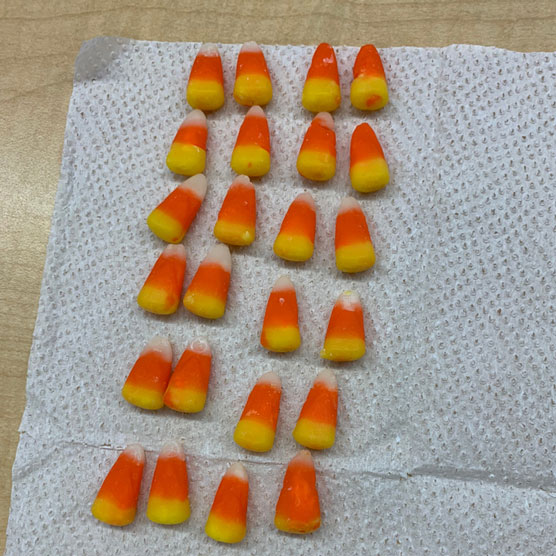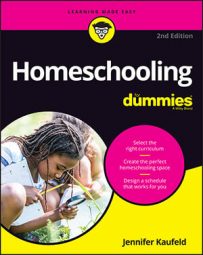 © Rachel K H/Shutterstock.com
© Rachel K H/Shutterstock.comTeaching math with candy corn.
You understand the symbols because you’ve done math for years, but if the code doesn’t click with your child, he’s going to have problems discerning the answers to the numbers on the page. Your goal is to make those symbols mean something. After the symbols have meaning, then true math learning takes place.
Just because your child can count to 100 by rote doesn’t mean that she understands what 100 may stand for. How many times did you hear the age-old ABC song before your child had any clue what those letters actually stood for? She sang the song, you applauded, and so she sang it again with even more gusto. The same can be true for counting by rote (1, 2, 3 . . . 98, 99, 100!).
You usually figure out your child hasn’t put concept and symbol together when you try to show him how to add or subtract a few of those numbers that he’s been chanting for weeks. That’s when everything falls apart if it’s going to — he may look at those symbols like he never saw them before. For all he knows, you may as well be teaching him to add and subtract Roman numerals.There is a way out of this dilemma. The solution is math manipulatives, an educational term for math help that you can get your fingers around. Math manipulatives can truly be anything that you can count or measure with, although some items function better than others:
- Base-ten blocks: These are counting blocks. Beginning with the one-centimeter cube and the ten-centimeter rod, a base-ten set adds a 100 block that looks like ten of the ten-centimeter rods fused together, and a large cube that represents 1,000. You can add and subtract large numbers with this set; all the blocks come in the same color so they look the same and the learner concentrates on the size instead of the color.
- Cuisenaire rods: These ten little rods range from one-centimeter cubes to pieces of wood that are ten centimeters long. Each rod is one centimeter longer or shorter than the others, they come in predictable colors (for example, the five-centimeter rod is always yellow), and you can use them to add, subtract, multiply, divide, and do fractions, among other things. One set of rods contains several of each rod length.
- M&Ms: You know them, you eat them, and now you can count with them, too! With a few bowls and a pile of M&Ms, you can add, subtract, multiply, divide, and have snack time all at once! (Fractions are tough with M&Ms.) Do it quickly, though; if you hold them long enough, they do melt in your hand.
- Pattern blocks: Using these little plastic tiles, your child learns about patterns, fractions, geometric shapes, and tessellations (patterns that fit into one another and arguably go on forever). Shapes include square, triangle, hexagon, rhombus, and trapezoid. If you want to play with these online before you track them down at your local educational store, visit the Math Learning Center website.
- Pennies: Although half-dollar coins are easier to find on the table, pennies are much cheaper if you happen to be counting to 100. These function the same as M&Ms, but you don’t get the added thrill of eating the chocolate when you finish math class. To drive home the point, you can always make your own ten-count penny sticks by gluing ten pennies to a strip of light cardboard. This way, your child knows there are ten pennies per strip because she patiently sat and glued each one of them. (Use water-soluble glue so you can reclaim the pennies after fourth grade.)
Miquon is a little weak in time (clock reading) and story problems, but it’s designed to lay a conceptual foundation in the first three years of elementary school. Children leave Miquon with the equivalent of a fifth- or sixth-grade math education, and they then move on to another program.
Here are some other math programs that you may want to take a look at:
- Beast Academy: Who doesn’t love a few monsters with their math? This program is designed for kids who like to be challenged. Designed for ages 8–13, each level includes an engaging comic book (called a Guide Book) that teaches the concepts along with a student Practice Book filled with problems and math puzzles.
- Key To series: This is where you go after Miquon. The Key To books present a single concept per page, and each set of booklets covers a particular topic: decimals, fractions, percents, measurement, algebra, or geometry. These books say they’re for grades 4 through 12; however, the geometry curriculum is “proofless geometry;” therefore, it doesn’t qualify as regular high-school-level geometry. This curriculum is currently published by McGraw Hill; available from homeschool suppliers or Amazon.
- Math Mammoth: This curriculum covers grades 1 through 7, and it does it either topic by topic or in a customary progression, your choice. It’s inexpensive as math curriculums go, and it’s comprehensive. Available in either digital or paper format.
- RightStart Mathematics: This curriculum augments lessons with a ton of varied manipulatives — a math balance, measuring tools, fraction manipulatives, and their own abacus. This is a full and solid math program. Levels A through H cover grades K/1 through about grade 8. (You begin with Level A with a child who cannot add or subtract, regardless of the age.)

